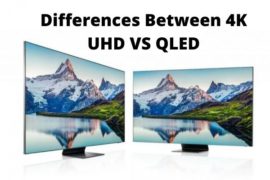Key Notes:
- Using a 4K Upscaler will produce a significantly better feed than the native full HD resolution on a 4K display.
- As there is still a lack of 4K contents in the mainstream, using a 1080p to 4k Upscaler will offer a viewing experience.
- It is better to use hardware when upscaling as they are faster and generate less overhead for the processor of the viewing device.
As 4k resolution is becoming more and more mainstream, the lack of older content in 4K format has been noticeable. An Upscaler can increase pixel count from the native resolution to suit high-resolution displays. So, what is a 4k Upscaler? How does it work?
An 1080p to 4K Upscaler converts 1080p contents to 4k resolution. With the native 1920 x 1080 pixel resolution, the Upscaler adds more pixels and turns it into 3840 x 2160 pixel contents. These Upscalers use different algorithms and techniques to generate all those extra pixels.
Although upscaled content might not be as good as native 4K, it would a big improvement over the native 1080p resolution.
Types of Upscaling
There are mainly three types of upscaling used to a large extent. These are software-based upscaling, AI upscaling, and hardware-based upscaling.
Software-based upscaling: Software-based upscaling uses different techniques and algorithms to convert 1080p contents into 4K.
But they all follow one main theme, and that is to generate pixels that were not there before.
So, how do they do that?
There are several methods. The principle is to check the color of the adjacent pixel where the new pixel is to be placed. The new pixel will get the average color of its adjacent pixels.
Software-based upscaling is often time-consuming but easy to implement.
Also, you will see blurry portions if you look closely. But its end result is far better than native 1080p on a 4K display.
AI upscaling
Although many includes AI in software upscaling, the use of artificial intelligence has changed the game.
AI, using its heuristic functions, can predict what will be the color of the next pixel to be generated.
Hardware-based upscaling
Hardware-based upscaling uses the same algorithms and techniques to generate the missing pixels.
The difference is that the device has its own processor to process the input stream.
So, there would no additional pressure on the viewing device’s processor. As a result, you won’t experience any latency compared to software upscaling.
Most Common Upscaling Techniques
| Type | Working Principle | Speed | Quality |
| Nearest Neighbor | Doubles the size of the pixels | Fast | Average |
| Bilinear Interpolation | Generates new pixels by averaging native pixels by a group of 4 | Slower | Balances color and sharpness |
| Bicubic Interpolation | Generates new pixels by averaging native pixels by a group of 16 | Slowest | Great color accuracy, not so sharp |
When To Use 4k Upscaler
If you have a lot of 1080p content that does not have 4K versions released yet, then you should definitely get a 1080p to 4k upscaler.
You will need an upscaler whenever you need to display any content that has a lower resolution than the display.
Especially if the difference is greater like 1080p and 4k resolution. In these cases, when you play full HD content on a 4K display you will get very low-quality output.
But you can remedy the situation by using a 1080p to 4k upscaler. The upscaler or converter will add the additional pixels to compensate for the missing pixels on the 4K display.
So, the end result will be far better than the native resolution. Although the converted frames will not be as good as native 4K, the difference will be noticeable with native 1080p.
My Recommended 1080p to 4k Upscalers
- Marseille mClassic
This plug-and-play upscaler is not only easy to use but also converts video in real-time. Which means you will experience no lag.
Just plug it in the source device and plug the one end of the display device into it, and you are set.
Also, it is compatible with PlayStation, Xbox, GameCube, and many more consoles.
- Gofanco
This device not only upscales but also automatically downscales when required. You can use it as a splitter too.
It supports up to 4K at 60 frames per second. The all-around metal enclosure minimizes the RFI/EMI noise interference. Dolby Atmos is also supported via AVR mode.
- UHD 4K Composite
Its plug-and-play approach makes it very easy to use. This converter comes with 2 conversion output ports.
Internal hardware is very good at converting the analog signal to high-resolution digital content.
Frequently Asked Questions (FAQs)
Can 1080p be upscaled to 4K?
Yes, 1080p contents can be upscaled to 4k.
How do I convert 1080p to 4K?
Yes, you can use hardware or software to upscale 1080p content to 4K.
Is it better to upscale 1080p or downscale 4K?
If you wish to downgrade to 1080p to view on a 1080p display you will get better 1080p than the native resolution. But when upscaling, the quality won’t be as good as native 4k.
What does 1080p upscaled to 4K mean?
It means the native 1080p resolution has been turned into 4k resolution by adding extra pixels.
Does upscaling improve picture quality?
It would be a significant improvement than playing native 1080p content on a 4K display. But they will be low in quality when compared to native 4K content.
Bottom Line
If you have a lot of content available in 1080p and you have a 4K display then getting an upscaler is the way to go. The upscaled 4K would look a lot better and offer a better viewing experience on a 4K display. As there is still a lack of 4K contents in the mainstream, if you wish to make most of your 4K display then you should definitely get a 1080p to 4K upscaler.
Related Posts:




